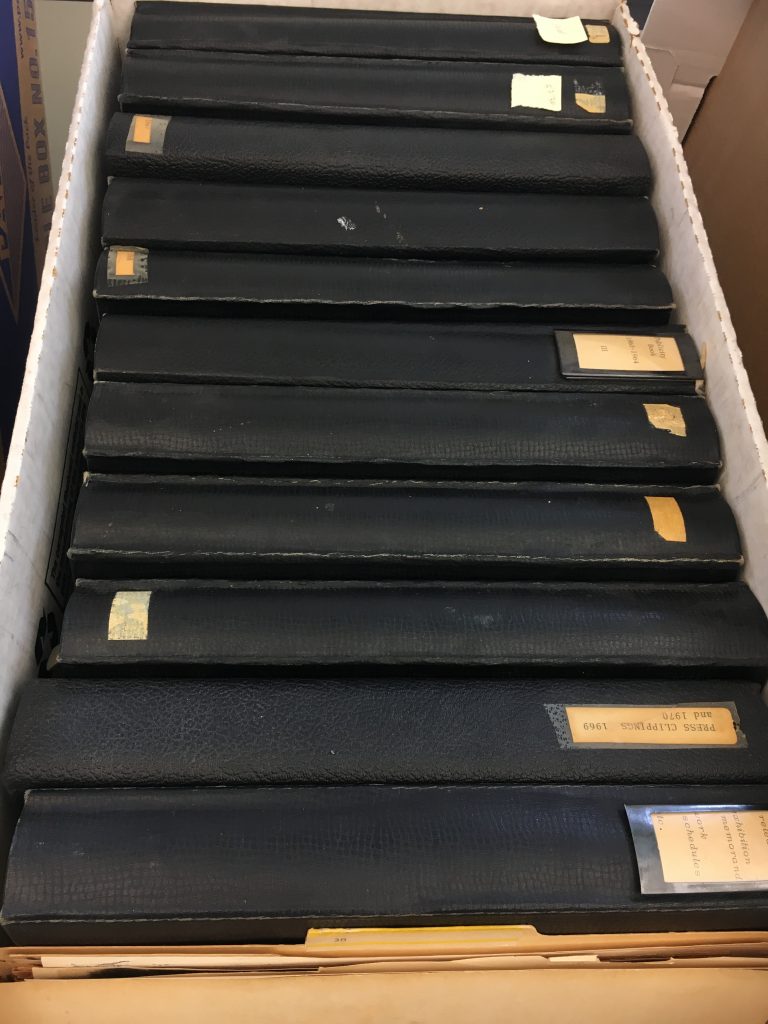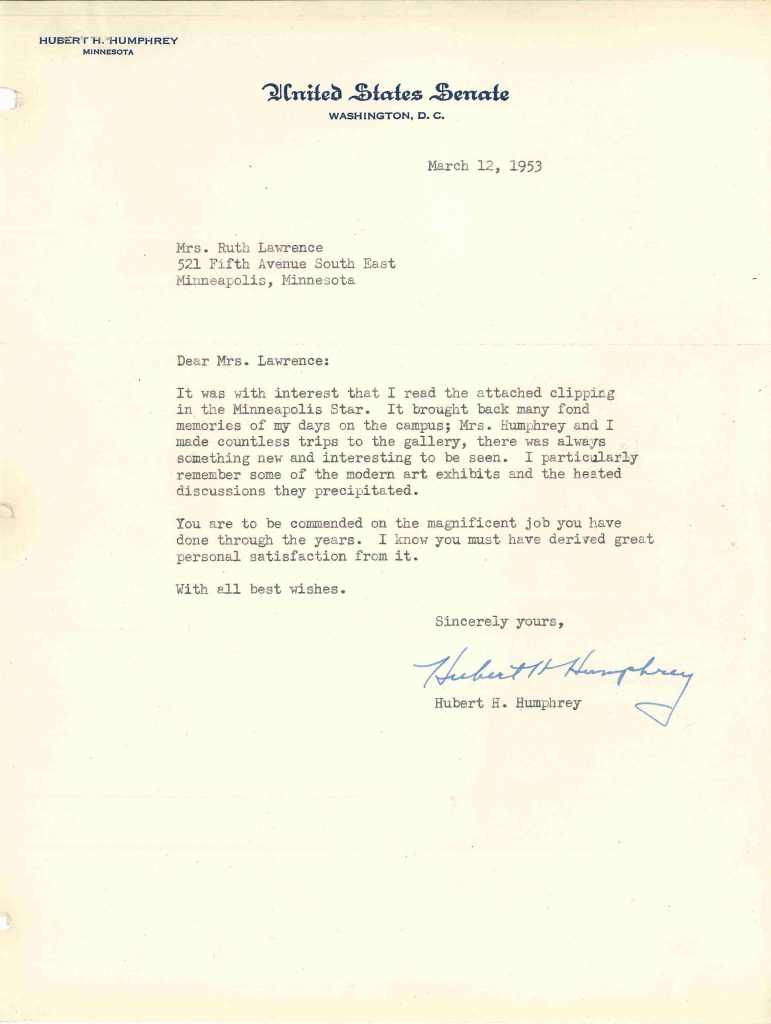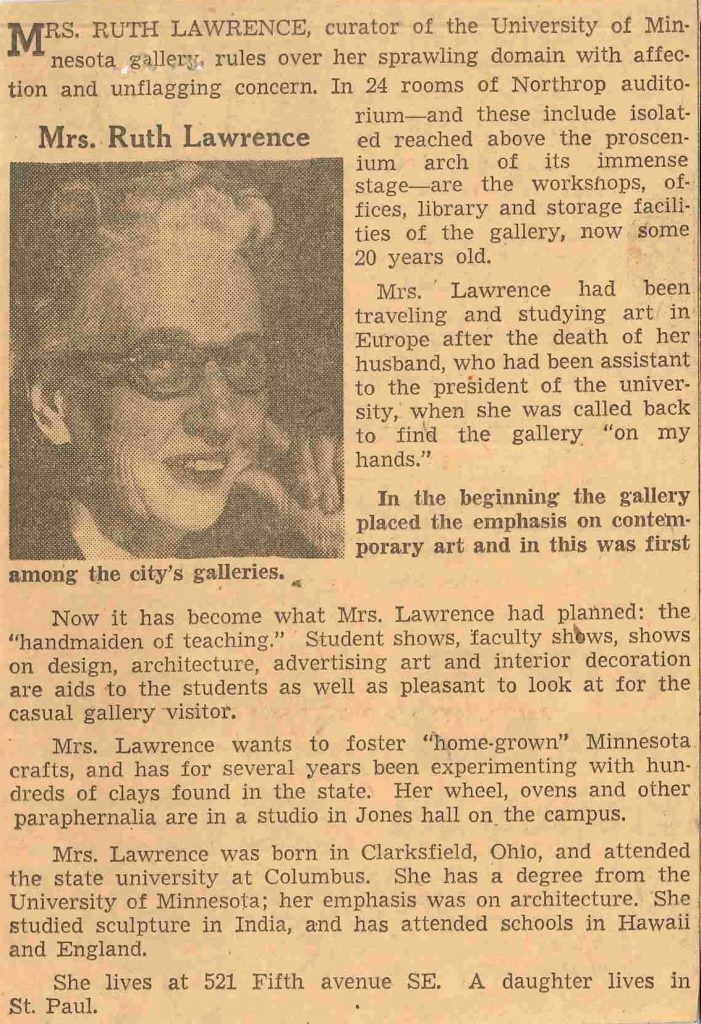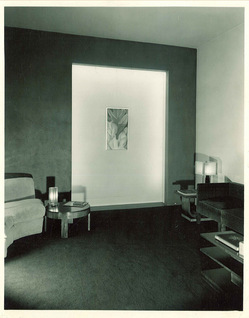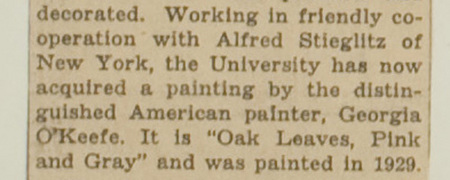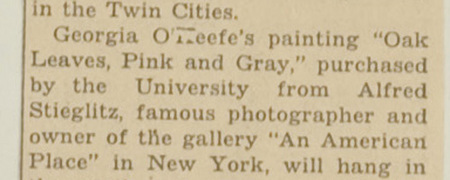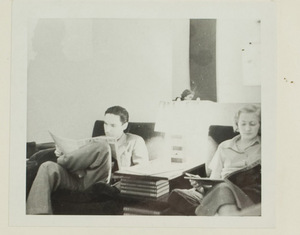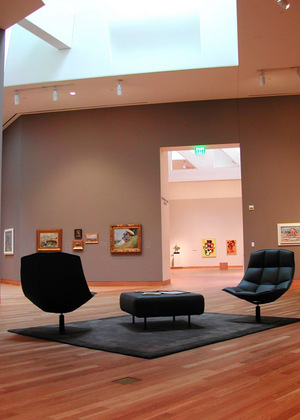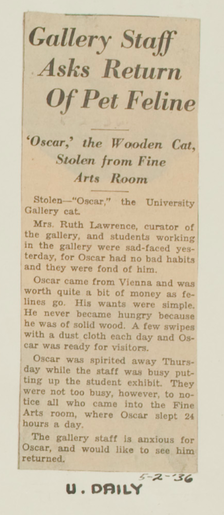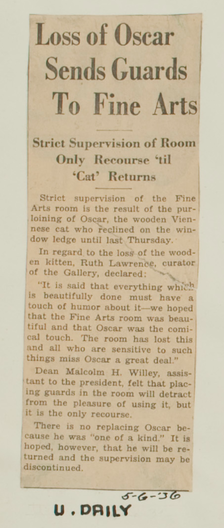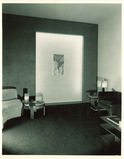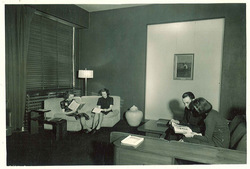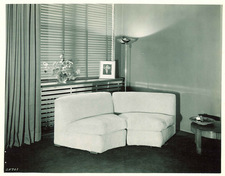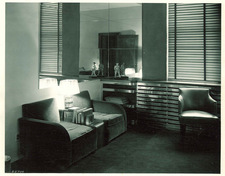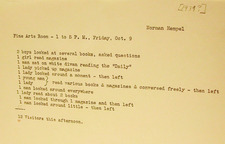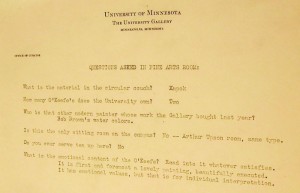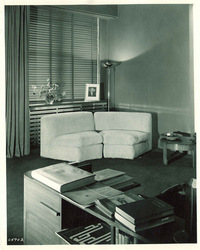 When the Fine Arts Room first opened adjacent to the University Gallery in Northrop Auditorium in February 1936, the reaction amongst faculty and students was not that of unanimous approval. The room, designed by curator Ruth Lawrence with modern furnishings, was in stark contrast to other types of interior decoration then on campus. The room included a kapok circular couch, as well as venetian blinds and large blue floor length drapes. Lawrence even had the audacity to vary the paint color — two walls were painted blue, the other two off-white. Dean of the College of Education, Melvin E. Haggerty, who was apparently shocked by the décor of the room — as well as its purpose — wrote to Malcolm Willey and President Lotus Coffman to express his concern:
When the Fine Arts Room first opened adjacent to the University Gallery in Northrop Auditorium in February 1936, the reaction amongst faculty and students was not that of unanimous approval. The room, designed by curator Ruth Lawrence with modern furnishings, was in stark contrast to other types of interior decoration then on campus. The room included a kapok circular couch, as well as venetian blinds and large blue floor length drapes. Lawrence even had the audacity to vary the paint color — two walls were painted blue, the other two off-white. Dean of the College of Education, Melvin E. Haggerty, who was apparently shocked by the décor of the room — as well as its purpose — wrote to Malcolm Willey and President Lotus Coffman to express his concern:
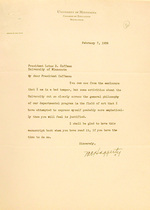 February 7, 1936, Dean Haggerty to President Coffman :
February 7, 1936, Dean Haggerty to President Coffman :
My dear President Coffman:
You can see from the enclosure that I am in a bad temper, but some activities about the University cut so clearly across the general philosophy of our departmental program in the field of art that I have attempted to express myself probably more emphatically than you will feel is justified.
I shall be glad to have this manuscript back when you have read it, if you have the time to do so.
Sincerely,
M.E. Haggerty
Haggerty included a manuscript titled, “The Artist and the Layman,” from a publication titled, “Arts & Progress,” dated 1915, the main point of which argued that “the idea which distinguished the artist as a different kind of being from the layman has led to an unfortunate and unnecessary separation in artistic education.” It further stated that in artistic training, even if an artist were to acquire the best technical training, he still has “little chance of knowing anything even about art. The one thing which he ought to have above anything else is critical judgment; and this can be formed only on the basis of serious and prolonged study of masterpieces of the past and of the present day.”
Such thought was in contrast to the intent and purpose of the Fine Arts Room, which was opened not to rigorously train artists, but to provide access to art and cultivate artistic appreciation for ALL University students. When Dean Malcolm Willey first proposed opening a Fine Arts Room to President Coffman, he wrote that he was inspired by the “theory that true appreciation of fine art comes from being in presence of a fine object under ideal conditions.” The origination of the Fine Arts Room was revealed in a letter Willey wrote to Coffman on June 1, 1935:
I should like to try the experiment of fitting up on our campus, as part of our attempt to increase interest in and appreciation of fine arts, a room which in its furnishings should be simple, but in impeccable taste, comfortable, and in every way lovely as a room. Into this I would put one art object at a time – one of the fine things we have bought… I would open this room as a retreat. No studying allowed, no textbooks admitted, no formal instruction. If the setting and the art object [cannot] induce the spell I am seeking, nothing else can.
Haggerty, not inclined to follow this philosophy, and still stirred up by the Fine Arts Room and the University’s approach to arts appreciation, wrote another letter, this time to Dean Willey:
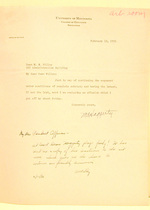 February 10, 1936, Dean Haggerty to Dean Willey:
February 10, 1936, Dean Haggerty to Dean Willey:
My dear Dean Willey:
Just by way of continuing the argument under conditions of complete sobriety and having the latest, if not the last, word I am enclosing an effusion which I got off my chest Friday.
Sincerely yours,
M.E. Haggerty
On the bottom of Haggerty’s typed letter is a hand-written note from Willey to President Coffman, whom he likely forwarded the letter to:
My dear President Coffman,
At least Dean Haggerty plays fairly! He has sent me a copy of his reactions to the art room, which gives me the chance to continue our friendly discussion.
M.Willey
In President Coffman’s reply to Dean Haggerty regarding the Fine Arts Room, and of art in general and its appreciation in the University, a reflection of Coffman’s well-held educational beliefs are asserted:
February 13, 1936, President Coffman to Dean Haggerty:
I think there may be something to your surmise that you got out on the wrong side of the bed the morning you wrote your reflections on visiting the new fine art room in Northrop Memorial Auditorium.
I agree fully with your general position that we should create an environment which will be artistic and attractive, which means that attention should be given to the architecture and the general style of our buildings, to the improvement of campus, and to doing everything and anything that will in any way contribute to making our situation more attractive and beautiful. Now from this point I think we might begin to have some differences of opinion.
I do not believe that all art is associated with utility as I think that many researches are carried on with just the researcher having any thought or conception of their value or use. I should have pictures and other forms of art about the campus even though I don’t understand them, just as I would have a beautiful chapel on the campus even though no one ever worshipped in it, or ever went there for prayers, or to hear the Scriptures read. I would have fine music played on the campus and I would reduce the rates, if I had my way, to a point which made it possible for the poorest to attend; I would do this even though I know that most of those who attend don’t understand a thing that is being played. I have often thought that it would be a most interesting psychological study for one to take an inventory of the thoughts that race through the minds of a hundred or more persons in the audience at one of the Symphony concerts. I find, for example, that I think about everything under the sun. I would have people live in an environment every feature of which makes some artistic contribution and I really would try to teach students as much as possible about these features, for I believe that appreciation and genuine understanding are closely related.
Mr. Willey said you sent him a copy of your paper. I am glad that you did. He told me that you and he are carrying on an interesting and animated discussion on the subject of art. Who knows, maybe your letters and his will be published some day just as Royce’s and James’ letters have been published.”
After reading this series of correspondence, a new appreciation is gained of President Coffman’s early advocacy of the arts and his enlightened educational philosophy.
